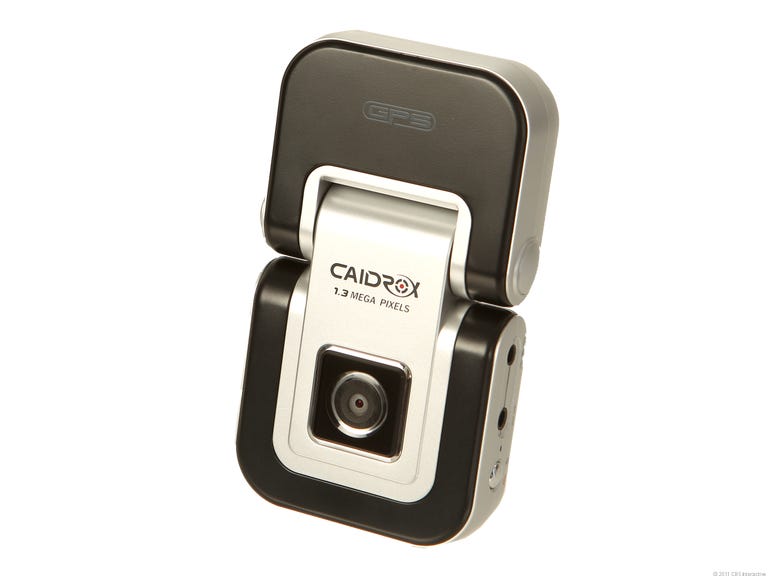Traffic accidents lead to many disputes, as drivers come up with different accounts of the incident. But inexpensive video, GPS, and accelerometers open the way for an always-on drive recorder, saving telemetry and a visual representation of everything that happened preceding and in the immediate aftermath of a crash.
The Good
The Bad
The Bottom Line
In the small field of products in this category is the Caidrox CD-3000, a device the size of a smartphone that can be attached to the windshield in front of the rearview mirror. The CD-3000 continuously records video and telemetry while you drive, saving 3 or 4 minutes' worth of data to a 4GB SD card whenever it detects an incident.
Design
The device is a little chunky in shape, and is composed of two hinged parts. The lower part contains the camera lens, and the hinge lets you aim it for the best forward view. The left side includes power and auxiliary video input ports, but these would be better placed on the right side, so as to keep wire clutter farther away from the driver.

The package includes a long power cord with a 12-volt plug, useful for stringing the thin wire along the top of the windshield, down the A pillar, under the dash, and to a 12-volt power point. The auxiliary video input supports an optional second camera, which can either show the rear view or focus in the cabin.
A plastic sheath with an adhesive strip comes with the CD-3000 for easy mounting to a windshield. The sheath holds the device in well, but there are also screw holes in the back to more firmly anchor it all together.
A 4GB SD card comes preloaded with the CD-3000's viewer software, although it is PC-only. The viewer shows recorded driving video in the main window, and a Google map in the upper right with the car's route. A lower bar shows speed, distance traveled, GPS coordinates, and an accelerometer graph.
The viewer is generally easy to understand, but the file list is not. Each time you drive with the CD-3000, it will save dozens of potential incidents, each as an MP4 file. The viewer lists these files by name. Although each file name includes the date and time, the notation is not very clear. A better solution would be to have the viewer parse the files, displaying a sortable list with the date and time in standard format.
Features
Along with its ability to record video from two cameras, GPS coordinates, and accelerometer information, the CD-3000 has a video output, letting you hook it up to a monitor and show its recorded incidents without a PC. To use the video out, the device will need to be powered from a 12-volt supply.
The MP4 output files can be viewed with most standard video player programs, but they won't include the telemetry and GPS information, just the video drive footage. The viewer software is not able to create a video in a standard format overlaying the telemetry and GPS data, which would be useful for extra file portability.

To communicate its operating state, the device uses LEDs. A blue light indicates the device is on, while a red light shows when it is recording. There is no power switch; the CD-3000 turns on when plugged in. The CD-3000 also has an internal microphone recording cabin audio, which might come in handy when providing evidence after an accident.
A beep sounds when the device begins saving an incident, which mercifully can be turned off using the settings from the viewer software. This beeping occurs frequently enough when driving to become annoying. The viewer software defaults to kilometers per hour, but can be switched to miles per hour in its settings.
Performance
With the CD-3000 mounted on a windshield, its wide-angle lens catches all of the action out front. It does cause a fish-eye effect, but that does not interfere with the ability to tell what is happening in the shot. Although not HD, the resolution is sufficient for the device's purpose.
When driving, the CD-3000 showed quite a bit of sensitivity, interpreting hard acceleration, braking, or bumps in the road as incidents worth saving. With default settings, each resulting MP4 file was about 23MB, so the 4GB SD card can hold quite a few. It is obviously better for the CD-3000 to be oversensitive, recording every jolt, rather than miss an actual crash. But it will make finding a particular incident tedious, given the viewer's poor file management.
The viewing software itself can be a little sluggish when responding to button inputs. When starting a drive file, it takes a moment for the Google map component to catch up with the video. The viewer interface is a fixed size, so it cannot be put into full-screen mode.
Average drivers, who get in only a few accidents over a lifetime, probably won't need a drive recorder. Nor is the CD-3000 appropriate for sport drivers. Action cameras such as the GoPro Hero and Contour offer much better resolution. The best use for the CD-3000 is for fleet vehicles, such as taxi cabs or delivery trucks.



